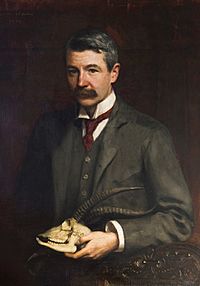Oldfield Thomas facts for kids
Quick facts for kids
Oldfield Thomas
|
|
|---|---|

Painting by John Ernest Breun
|
|
| Born |
Michael Rogers Oldfield Thomas
21 February 1858 Millbrook, Bedfordshire, England
|
| Died | 16 June 1929 (aged 71) |
| Known for | Mammalogy |
| Scientific career | |
| Fields | Zoology |
| Institutions | Natural History Museum |
| Author abbrev. (zoology) | Thomas |
Michael Rogers Oldfield Thomas (born February 21, 1858 – died June 16, 1929) was a British zoologist. He was a very important scientist who studied mammals. He described many new kinds of animals during his life.
Contents
Studying Mammals
Michael Oldfield Thomas worked at the Natural History Museum in London. He started there in 1876. In 1878, he moved to the zoology department. This is where he focused on studying mammals.
He became famous for describing about 2,000 new species and subspecies of mammals. This means he was the first person to officially name and describe these animals for science.
In 1891, Thomas married Mary Kane. Her family had some money. This allowed him to hire people to travel the world and collect mammal specimens. These specimens were then brought back to the museum for him to study.
Thomas also traveled himself. He did field work in places like Western Europe and South America. His wife, Mary, loved nature too. She often went with him on these collecting trips.
In 1896, a new head took over the department. This allowed Thomas to spend even more time on his important work. He focused on studying all the new animal specimens that were being collected.
Thomas believed it was important to understand all the mammals in the world. He worked hard to fill in the "blank areas" of knowledge about them. He officially retired from the museum in 1923. But he loved his work so much that he kept doing it without stopping.
Animals He Described
Michael Oldfield Thomas named many different groups and types of mammals. Here are some examples of the higher groups and specific animals he described:
Higher Groups
These are larger groups of animals, like families or subfamilies.
- Deomyinae (a group of mice and rats)
- Desmanini (a group of mole-like animals)
- Myzopodidae (a family of bats)
- Ochotonidae (the pika family)
- Phalangeroidea (a group of marsupials)
- Procaviidae (the hyrax family)
Genera (Groups of Species)
These are smaller groups, like a genus, which contains one or more species.
- Aethalops (a type of bat)
- Aethomys (a type of mouse)
- Ammodorcas (a type of gazelle)
- Batomys (a type of rat)
- Belomys (a type of flying squirrel)
- Callicebus (a type of monkey)
- Cistugo (a type of bat)
- Dacnomys (a type of rat)
- Damaliscus (a type of antelope)
- Diplogale (a type of civet)
- Dromiciops (the monito del monte)
- Eupetaurus (a type of flying squirrel)
- Galeopterus (the colugo)
- Glaucomys (a type of flying squirrel)
- Hylochoerus (the giant forest hog)
- Ia (a type of bat)
- Ichthyomys (a type of fish-eating rat)
- Leggadina (a type of mouse)
- Leporillus (a type of stick-nest rat)
- Mallomys (a type of giant rat)
- Mastomys (a type of multi-mammate mouse)
- Microgale (a type of shrew tenrec)
- Myoprocta (a type of agouti)
- Neacomys (a type of spiny mouse)
- Otomops (a type of bat)
- Petaurillus (a type of pygmy flying squirrel)
- Pteralopex (a type of fruit bat)
- Rhabdomys (a type of striped mouse)
- Rheomys (a type of water mouse)
- Scotinomys (a type of singing mouse)
- Scutisorex (the armored shrew)
- Sminthopsis (a type of dunnart)
- Taterillus (a type of gerbil)
- Vampyressa (a type of bat)
- Xeromys (the false water rat)
- Zyzomys (a type of rock rat)
Species (Specific Animals)
These are individual species of mammals he described.
- Admiralty flying fox
- Azores noctule (a type of bat)
- Bare-tailed armored tree-rat
- Beatrix's bat
- Bonthain rat
- Dayak fruit bat
- Desert woodrat
- Egyptian pipistrelle (a type of bat)
- Ethiopian hare
- Forrest's pika
- Great evening bat
- Guadalcanal monkey-faced bat
- Hairy-footed flying squirrel
- Harpy fruit bat
- Indonesian mountain weasel
- Intermediate long-fingered bat
- Junín red squirrel
- Korean hare
- Lagos serotine (a type of bat)
- Lesser long-fingered bat
- Bengal slow loris (a type of primate)
- Maclear's rat
- Goeldi's marmoset (a type of monkey)
- Monito del monte (a small marsupial)
- Mount Popa pipistrelle (a type of bat)
- Mouse-like hamster
- New Guinea long-eared bat
- Opossum rat
- Persian vole
- Pygmy fruit bat
- Sculptor squirrel
- Southern common cuscus (a type of marsupial)
- Spinifex hopping mouse
- Strange big-eared brown bat
- Sulawesi giant rat
- Szechwan myotis (a type of bat)
- Taiwan field mouse
- Thomas's yellow bat
- Tiny pipistrelle (a type of bat)
- Velvety fruit-eating bat
- White-bellied lesser house bat
- Woolly flying squirrel
- Woolly-headed spiny tree-rat
See also
- In Spanish: Oldfield Thomas para niños
- Category:Taxa named by Oldfield Thomas

